Having a fully stocked pantry for everyday life or for emergency situations is not always an easy task, there are often so many different variations of foods and varying opinions on what you should and shouldn’t have.
I understand the great task of stocking your pantry with both nutritious and long-lasting foods is no easy feat so I have compiled a list of ‘throw this away’ or ‘swap this out’ items.
I understand that the economic situation of today it is not suitable to just throw food away. So for the foods that wouldn’t last in a situation where you want a pantry for emergencies then what I like to do is find recipes including those foods I would like to get rid of and use them up as soon as possible.
This means making space to replace them with a better option that would be more appropriate in SHTF situations all whilst avoiding wasting what you already have.
This also saves money while still advancing your pantry to one you would feel more confident and trusting in, if things were to head south.
Related: What Do I Store in My Pantry As a Prepper?
Moving older foods and cans to the front so that you are getting the most out of the foods you do have is a highly beneficial and resourceful practice.
I would recommend putting any foods you recently purchase to the back of the pantry so you are accessing the older stuff products first and leaving the newer items at the back.
Unsealed Jars
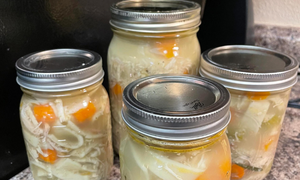 A lot of foods are still edible after expiration, although they do lose some of their properties. If they are stored correctly and sealed they will be okay.
A lot of foods are still edible after expiration, although they do lose some of their properties. If they are stored correctly and sealed they will be okay.
However, eating canned foods in jars is not safe to eat if not properly sealed and should be thrown away immediately.
The best you can do if you notice the jars are not properly sealed ahead of time is repeat the canning process.
Herbs And Spices With Added Preservatives
Get rid of them, they don’t last and encourage moisture. Next time, look for ones with the herbs and spices as the only ingredients. Better yet being able to grow herbs yourself is highly advantageous.
Brown Rice
Now this sounds controversial, right? But hear me out. Brown rice is often viewed as the healthy option but brown rice often only keeps for 6 months.
So ditch your brown rice for white rice which has a shelf life of 2 years or more.
Metal Cans With Rust Or Leakage
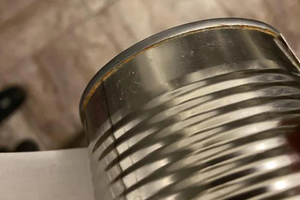 Rust is known as oxidized iron and it is absolutely not safe to eat. Any rust on the inside of the metal can should definitely not be consumed as it is dangerous and harmful.
Rust is known as oxidized iron and it is absolutely not safe to eat. Any rust on the inside of the metal can should definitely not be consumed as it is dangerous and harmful.
If your food cans are leaking or bulging these should also not be consumed as these have not held their seal.
Related: Foods You’ve Been Storing Wrong Your Whole Life
They can contain clostridium botulinum which is a bacterium that produces dangerous toxins that is extremely lethal to humans.
Anything Half Opened And Not Sealed Up
When it comes to your pantry lasting you need to be on top of sealing and containing any left-over or half used foods, particularly pasta as these can attract pantry moths.
You are wanting to have your pantry well stocked and preserved for when and if you need this in an emergency and having these dreaded moths feeding on your food is not ideal. Keep an eye out for them as they don’t enjoy dried foods particularly.
Sugar Filled Commercial Cereal
 Not to mention the fact that these will provide you and your family with absolutely no nutritional content they can go off and become moldy rather quickly due to the high sugar content.
Not to mention the fact that these will provide you and your family with absolutely no nutritional content they can go off and become moldy rather quickly due to the high sugar content.
Rolled oats are a much better option and they are also multipurpose and can be used in many different recipes.
Cornmeal
Although we know cornmeal is a great source of zinc and starch this will have to be rotated out with new stuff as the shelf life is only 9 months.
Corn flour lasts longer than cornmeal due to the lower oil content and lower moisture content meaning it can last 2 years or more in correct storage.
Having a well-stocked pantry can help you and your family face many situations whether that be financial hardship or general SHTF situations where you should be able to make meals to both energize and please you during tough times.
Not only is a well-stocked pantry of food vital but it is also just as important for your pantry to have a large stock of water too.
There are always threats to our economy and livelihoods but having peace of mind about the fact you have the tools and means to support and supply for you and your family is a real weight off your shoulders.
Of course, there are many important foods to build your stockpile and pantry but this article was a look at what we should take out of our pantry to ensure longevity where we can for both an economical and practical outcome.
You may also like:
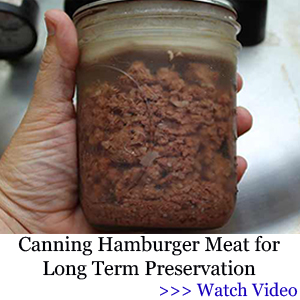 7 Guns Preppers Need To Buy Before The Upcoming Gun Ban
7 Guns Preppers Need To Buy Before The Upcoming Gun Ban
Learn An Insanely Effective Way To Build A 5 Year Food Stockpile (Video)
The 10 Cent Medicine That Every Prepper Should Have In Their Home

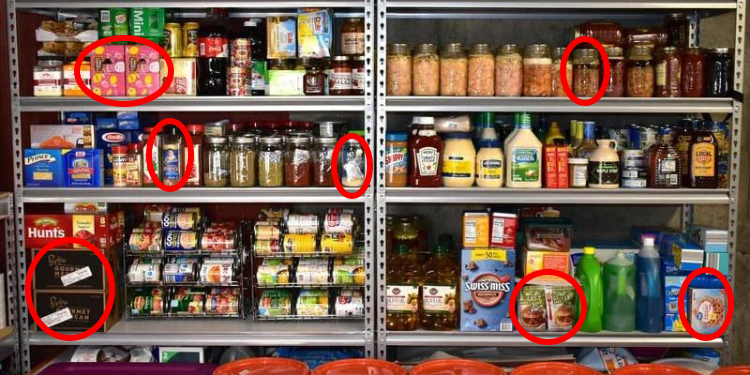



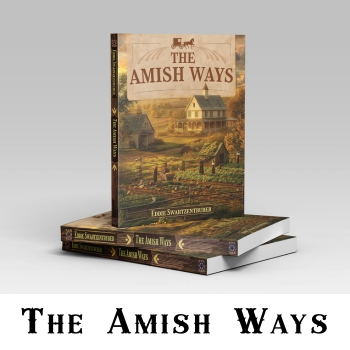








Would grits fall under the same restrictions as corn meal?
It’s my understanding that they will last a couple days in the frig, about 6 months in the freezer, and a year in the pantry if properly resealed. Up to 2 years on the shelf if unopened and properly sealed. This is my understanding and I’m confident that this is the longest anyone should store grits, given they’re properly sealed. I’m sure there are other options and best practices.
When using a vacuum sealer and storing in a deep freeze, You and extend the life of most anything, including foods that say “6 months in the freezer”, that term generally applies to the freezer in your kitchen refrigerator. A deep freezer is colder. I wrap meat that I have vacuumed sealed tightly in foil to help prevent freezer burn. Of course, long power outages can be a problem but when that happens, just do not open the freezer unless it is absolutely necessary, and even then only do that at night or early morning, not in the heat of the day. I make my own saurkraut in a covered crock where it will last a long time but I prefer to put it in quart jars, hand sealed, (no heat), and stored in the spare refrigerator in the laundry room. And whenever possible, get a second fridge if you have space, that can be a lifesaver. It does not have to be the top of the line.
I had to look TWICE at your post. I thought it said GIRLS. not GRITS! lol
Maybe we should rotate them out too?
They do tend to get spoiled pretty quickly ya know.
I thought the same thing, and I are one!! LOL!!
After I saw it said GRITS, I thought, why the ‘ell would anyone WANT to store those?
They are nasty fresh or stored!! LOL!
They also have nearly ZERO nutritional benefit!
This is ridiculous! I’ve had corn meal ca yum packaged for 3-4 years. Grits in mason jars with oxygen absorbers. They’re fine 3-4 years too.
That should have said “vacuum packaged”.
Googling ‘grits’ I see it’s basically ‘corn porridge’ is that right? A good alternative for those not able to eat oats…?
What about using Mylar bags to store your own food, I have oxygen absorbers and silica gel desiccant “dry & dry”. That I use in some of my things, but definitely check which items to put them in bc they will make some things hard as a rock such as sugar. But great for long term storage for a lot of things.
We reuse the peach jars from Costco for storing rice. We warm the jars in the dishwasher and take short grain brown rice when purchased and put it in the jars, seal them with the original lids and store them in a closet at a consistent 70 degrees. We have never had an issue with the rice even after a couple years. Quite a few of the lids even fully seal and pop when first opened. The jars make great storage containers for a number of foods and break larger quantities into smaller portions allowing you to keep larger quantities fresher longer.
Grits are high in calories and supply a moderate amount of B vitamins. Hominy (from corn Nixtamalized in lye water) grits, unlike untreated corn products, are a good source of Niacin. Possum is like pig except you skin it, just cut the carcass into pieces and slow roast it, keep a little water in the bottom of the pan so as the fat renders you’re making gravy, grits with possum gravy is hard to beat. Just be sure you don’t try it with one of those garbage eating city possums…
Depends on the grits you get. Buy the store bought commercial crap and there’s no nutritional value to speak of because they remove the germ and the rest of the good stuff. I buy my grits ground and packaged from the whole kernel from Nora Mill in Helen, Georgia. You can buy them directly from Nora Mill online.
Did not know that about cornmeal. Dang! Guess I’ll have to throw away what I have on hand.
just give it the smell test first – if the natural oils in the corn meal hasn’t gone rancid, put it in the freezer or use it. If the smell is off… I would use it in the garden / compost vs tossing it
What if I freeze dried the cornmeal, do you think it would last better than a couple years in a milar bag then?
That is what I was thinking, as if I did not have enough things to freeze dry as it is.
Maybe I will take second or third look at that new Harvest Right freeze dryer they are offering at $500 off. It is twice the size as their large.
I keep my grain/flour products in their original containers in the freezer in zip lock bags! Have for many years.
With the brown rice, and I’m assuming the same would be true for red and black rice, would it last longer if vaccuum sealed with an O2 absorber? an O2 absorber and a dessicant?
Would that possibly be true of the corn meal? Would stuff go rancid if it had no oxygen?
I call b.s. on the brown rice longevity. I’ve had the bulk sacks that I’ve bought from Costco stored for several
(5-7) years that on I’ve eaten with no discernable taste whatsoever.
90% of people’s pantries just got thrown away ???
Lol, don’t throw it away….eat it. Or at least give the rice to the birds.
Do NOT give rice to birds! It swells and kills them, that is why they say do not use rice to throw at weddings.
We have a rotational pantry. Everything gets used and replaced. First in, first out. We get mainly organic stock and we are starting to grow a lot of our yearly veggies.
Growing your own is much better. Even though it says organic isn’t always true because they put chemicals in it just for shelf life. Especially meats so you are still getting toxic chemicals in your body unfortunately.
The oxygen packets come in pouches of 10. Once you open them, how do you close them if you don’t use all 10 of the packets, and how long, once opened, how long do you have until they are no longer useful?
Should say on the packaging?
Place the unused packets in a mason jar with a lid and ring. Do it as quickly as possible, as the O2 absorbers will start absorbing the O2 in the air. Can’t help you on the life expectancy of the O2 absorbers. Good Luck.
IMO only, If you are on the verge of starvation and this is all you can find…EAT IT! what’s the worse that can happen you will die anyway?
Home freeze drying units have only been on sale for about three to five years. They are still very expensive.
I’d get me an Excalibur dehydrator. The company is over thirty years old. You can also buy one directly from the factory. It can be used to dehydrate cans of hominy. Then you can grind it up into cornmeal or grits at home.
Yes those are great!! I have a friend that has one.
These are great tips, much appreciated. Thank you.
About Grits:
There are two types of grits: those treated with lye and those that are “natural”. The type treated with lye have had all of the nutrition leached out of them by the lye. They are about as healthy as the cardboard box they came in. You want the types that have NOT been treated with lye (also called “caustic soda”).
I’m not sure about the storage longevity of the natural grits, it may be the same or less than the treated grits, but the nutritional value is much higher than the treated grits. The reason they are treated with lye is that they are made with “Field Corn” (it used to be called “Horse Corn”) because it had much larger and tougher kernels than Sweet Corn. The lye dissolves the tough outer layer of the Field Corn, but then the treated corn must be rinsed several times and this removes almost all of the nutrition. Some companies attempt to fortify the grits but it doesn’t really stick to the grits.
The natural grits will be more expensive than the treated grits because they are made with dried Sweet Corn instead of dried Field Corn. The dried Field Corn is left untreated and cracked instead of ground and then used for horses and deer.
I am a retired school food inspector from the Texas Dept. of Agriculture and this is something we looked for during our inspections of the schools across the state.